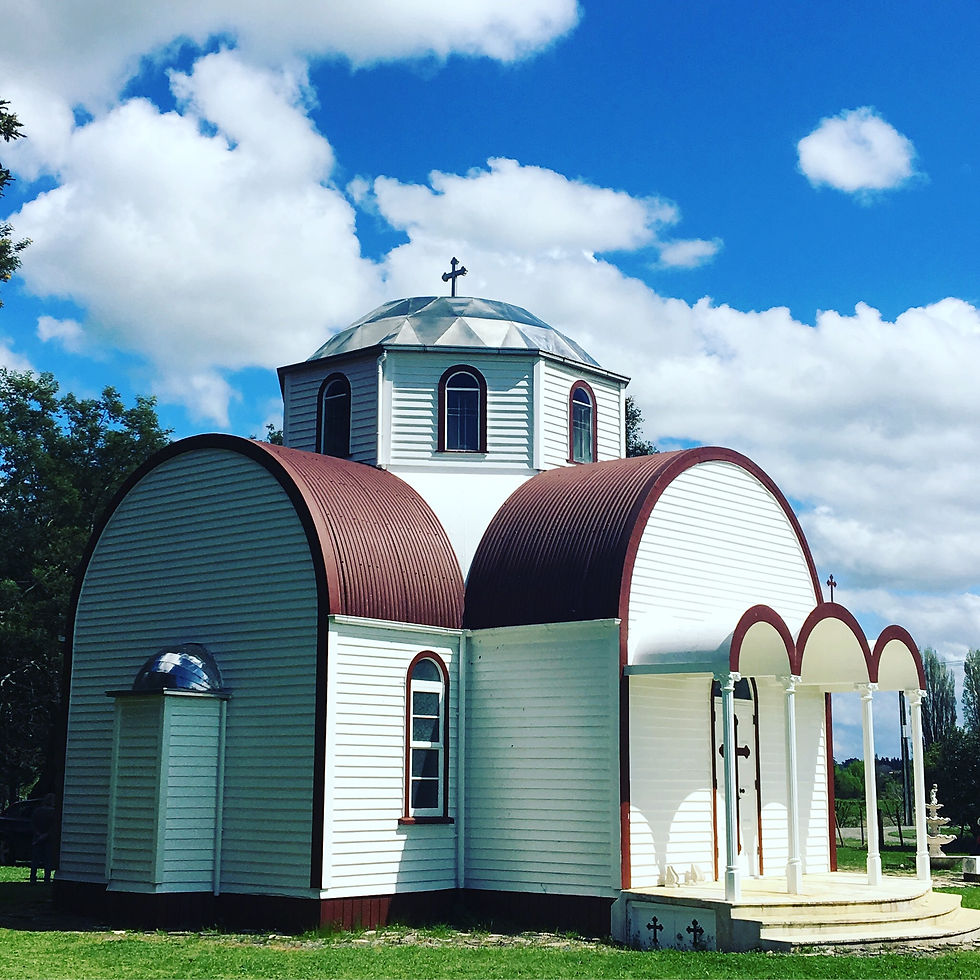Iconic
- Frankie
- Apr 12, 2020
- 4 min read
Updated: Jun 30, 2020
The Greek Orthodox Church of the Transfiguration is an architectural curiosity in the Wairarapa landscape and a source of intense public interest. Marguerite Tait-Jamieson takes a look inside.
Entering the Greek Orthodox Church of the Transfiguration is stepping into a whole new world. The rich colour, distinctive iconography, and beauty of the interior are in sharp contrast to the simplicity of many Roman Catholic and especially Protestant churches. This little church has been sitting plonked in a paddock in the middle of the farming community, for forty years.

It arose from the vision of two men – one a Greek immigrant, George Pantelis, and the other a young art student, Stephen Allwood.
George came to New Zealand in the 70s and settled in Masterton. He ran a restaurant which catered for people with a penchant for large steaks and very late nights. George was large and extremely strong, with a personality to match, well able to deal with any stroppy diners. He wanted to build a church in the Wairarapa to leave a legacy, and because he was extremely devout.
George had formed a friendship with a trustee of the Methodist church, and through him found and shifted the church at Mauriceville to form part of the church that now stands on Paierau Road, just north of Masterton. The remainder of the building was added using material he found in the district. The stainless steel dome was manufactured by a local company, Progressive Engineering.

The church is constructed in the form of a cross and is divided into three areas: the narthex, the nave, and the sanctuary. Centuries ago the narthex, just inside the entrance, was the place where catechumens (unbaptized learners) and penitents remained during parts of the services. It’s the area where the faithful make an offering, receive a candle, light it before an icon, and offer a personal prayer before joining the congregation. The nave is the large central area of the church. This church follows the old custom of having an open nave with no seats. The sanctuary is considered the most sacred part of the church, and is reserved for the clergy and their assistants. It contains the Altar or Holy Table and is the heart and focal point of the church. It is separated from the nave by the Iconostasion, a screen decorated with icons (images). This division serves to remind the faithful that sin incurs a ‘separation’ from God.
On trips back to Greece George acquired lights, artefacts, and a book by Photius Kontoglou, a 20th century icon painter who described particular icons in full detail and specified where to put them in the church. The icon or holy image is the distinctive art form of the Orthodox Church. In practice the icon may be a painting on wood or on canvas, or a mosaic or a fresco on the walls of the church itself. Icons depict such figures as Christ, Mary the Theotokos (mother and child), the saints, and angels. They may also portray events from the Scriptures or the history of the Church. The icon is not simply decorative, inspirational, or educational. Most importantly, it signifies the presence of the individual depicted, in effect being a window between heaven and earth.
In 1979 George commissioned Stephen Allwood, a second-year student at Ilam Art School in Christchurch, to fill the church with icons. Stephen arranged to take a year off and started painting in January 1980 with the intention of completing it before going back to art school in 1981. He’d worked out that he would need to paint one icon a week in order to complete the task on time. Each week George would translate the relevant chapter from the Kontoglou books, and Stephen would get to work.

The technique used was not the traditional one, using flat colours to paint the icons; Stephen’s preference was to use a translucent glazing technique in oil paint. He would lay a rich yellow colour over most of the Icon he was painting. Then with a glazing medium he built up contours using pure colours. Only on the last layer would he use white for the details. The effect is similar to stained glass and gives the icons vibrancy.
Not everyone liked the result – some of the Greek Clergy thought it was a bit bright, but it must have passed muster with them, as a couple of years later Stephen was commissioned to paint three big icons for the Greek Cathedral in Wellington.
Stephen finished the icons by February 1981, in time (with two weeks to spare) to complete his degree at university that year. George later moved to Australia. At the beginning of 2019 he booked a flight, with the intention of visiting New Zealand. He was too unwell to get on the plane and died in February.
The church is opened infrequently. Last year during the Kokomai Arts Festival it hosted sold out talks and Baroque music performances. It was opened again for Christmas carols in December.
Stephen Allwood has an exhibition at Bowen Galleries later this year.





Comments